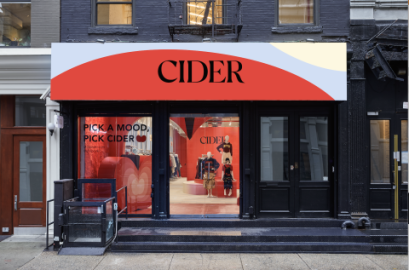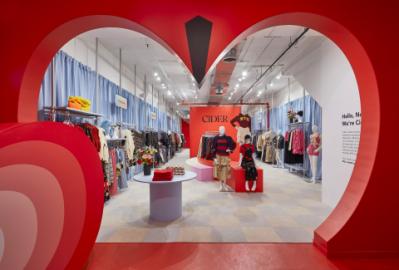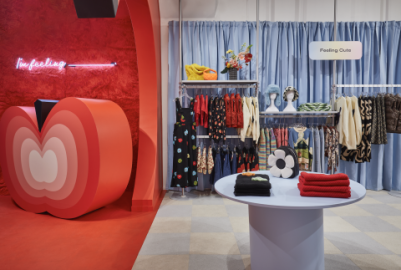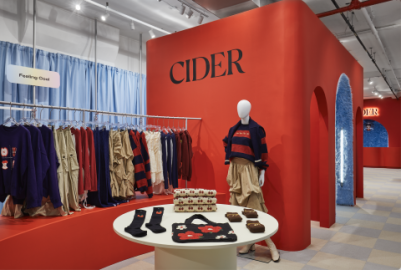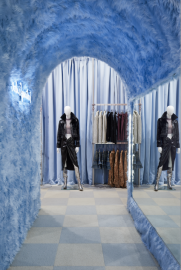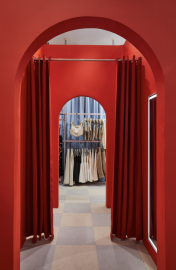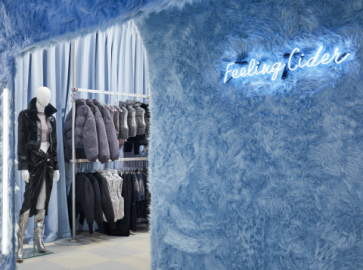Exclusive: Gen Z fave Cider opens first store in New York City
A fast-growing online brand is making its physical store debut in one of the Big Apple’s trendiest neighborhoods.
Cider, a digitally-native young women’s clothing and accessories brand known for its very affordable prices and “smart fashion” model, has opened a holiday pop-up in New York City’s SoHo neighborhood. Open Nov. 4 through Jan. 15, the 2,000-plus-sq.-ft. store boasts a colorful, fun design and carries some 400 SKUs in a wide array of sizes. The space also features a “Cider Basics” section as well as a special “NYC Capsule” collection with an embroidery station for personalization.
Based in Los Angeles, Cider credits a “social-first approach to fashion” for its swift success. Since it launched in 2020, the brand has caught the attention of fashion-savvy Gen Z customers, creating a community of more than 7 million online and app-based shoppers across more than 130 countries. It has more than 5 million followers on Instagram.
Eager to meet its customers, Cider opened branded showrooms in Seoul and London in June and July 2023, respectively. The spaces enabled customers to preview merchandise, but the goods were not available for purchase. Building on the success of the showrooms, Cider decided to open a temporary store in New York.
In addition to selling merchandise, the pop-up will also host dedicated events for Cider influencers and VIP customers.
“Our brand is inspired by the vibrant and diverse street styles of New York, Los Angeles, Paris, Shanghai and Seoul,” Yu Oppel, co-founder and chief marketing officer, Cider, told Chain Store Age at an exclusive press event. “Making our retail debut in the Big Apple at the start of the holiday season coincides with our branding and allows us to pay homage to our roots.”
To bring the space to life, Cider partnered with Ringo Studio, a firm known for creating immersive retail designs for brands that include Glossier, Our Place and Bala.
Oppel, Cider co-founder and chief fashion officer Fenco Lin, and Madelynn Ringo, founder of Ringo Studio, discussed the elements of the new pop-up store and Cider’s physical store strategy.
Why did you choose New York City as the backdrop for your first pop-up store?
Lin: New York is our biggest market in the United States, and there is a strong fashion influence here. Additionally, our store occupies the former flagship location for the chic street-style brand Opening Ceremony. So there is a lot of history here.
What design elements were used to make the space your own?
Ringo: We wanted to make a statement in the iconic space. Our goal was to focus on Cider’s vibrant signature colors as well as its “red apple” brand mascot. We added oversized, playful three-dimensional designs, including a cut-out apple entranceway and oversized disco ball over the cash-wrap. We also played up the hardware in the space, such as painting the pipes in Cider’s signature red color.
We also incorporated modular displays throughout the store. These displays can easily be packed flat and reused in different ways in other sites. They are cost-effective, sustainable design elements.
What else can you tell us about the store?
Ringo: Adding “fun moments” was definitely a priority. For example, we created a fitting room area out of a 9-foot tunnel covered in blue fur. It features an LED neon light “Feeling Cider” sign on one wall and a full mirror on the opposite wall, which invites selfies. Four dressing rooms separated by red curtains are located outside the tunnel. The curtains can be opened so friends can engage with each other while shopping.
Oppel: We also wanted to bring our app to life inside of the store. Similar to shopping with our app, the pop-up invites shoppers to “Pick a Mood” when browsing our signature collections: Feeling Cute, Feeling Romantic, Feeling Cool, Feeling Elegant, Feeling Nostalgic and Feeling Festive.
Cider operates on what it calls a “smart fashion” model. What does that mean?
Lin: It means we only produce what we know our customers want. Unlike traditional fashion companies, we don’t produce large quantities of merchandise. We use direct feedback and insights from our vast network of customers — especially our “super-fans” and social media influencers — to create and release new styles, and can adjust production in real-time based on demand.
We also have tight, optimized supply chain and inventory management systems that allow us to deliver fashion more quickly, affordably and with less waste.
What role does technology play in the pop-up?
Lin: Technology is very important to us, especially for inventory management. On average, most retailers carry between 30% and 40% excess inventory at store-level. We have a less than 5% rate.
To keep inventory levels lean, we have embedded an RFID tag inside each piece of merchandise, and a database inside of the store monitors each item’s movement. As merchandise is purchased, our database connects to our inventory management and supply chain systems so we can replace merchandise in real-time.
We use also analytics to analyze demand and customer preferences so we can accurately produce inventory.
Looking ahead, what does your physical retail strategy look like?
Lin: Based on the success and sales data garnered from our temporary New York City store, we would like to open additional pop-ups and permanent stores both here in New York as well as globally. We plan to target cities where are customers are, such as in Seoul, London and Paris.


